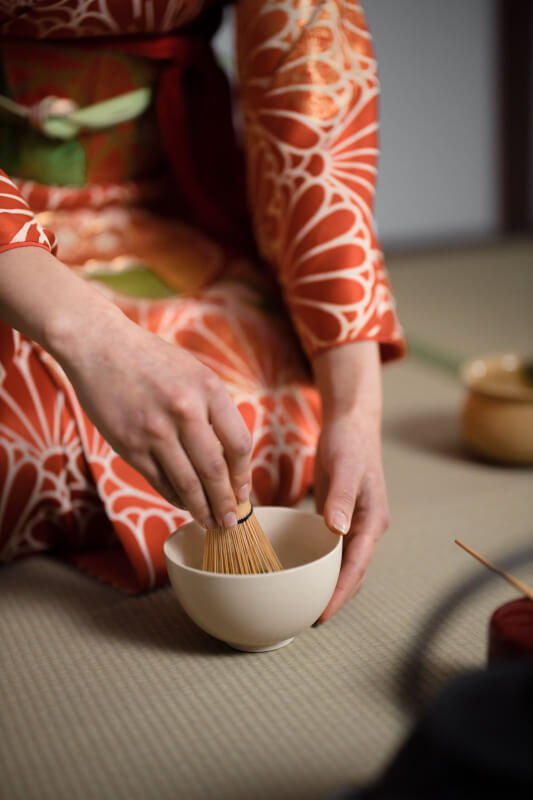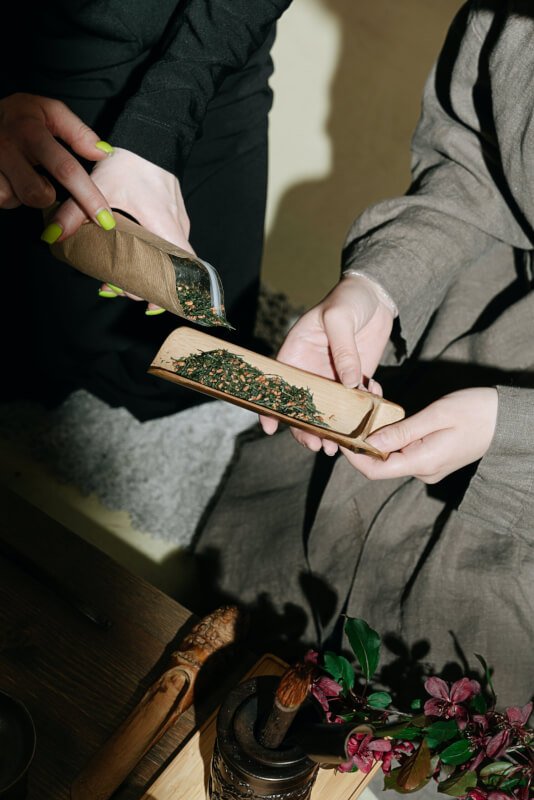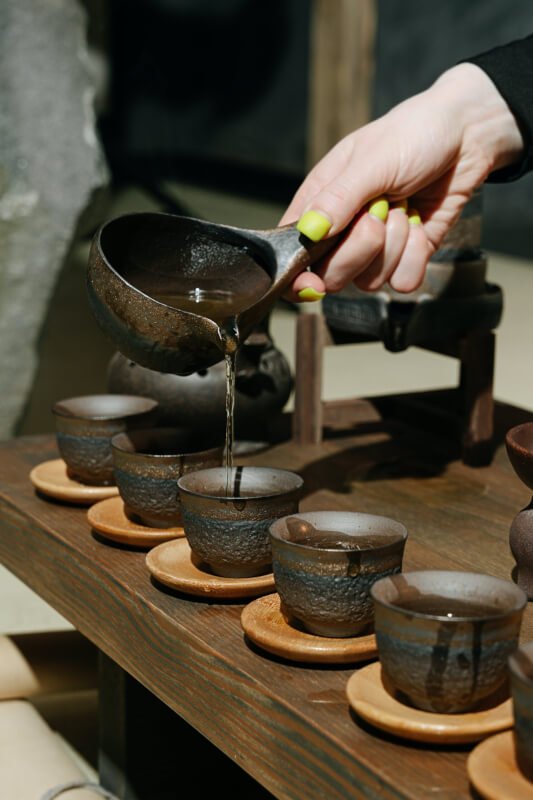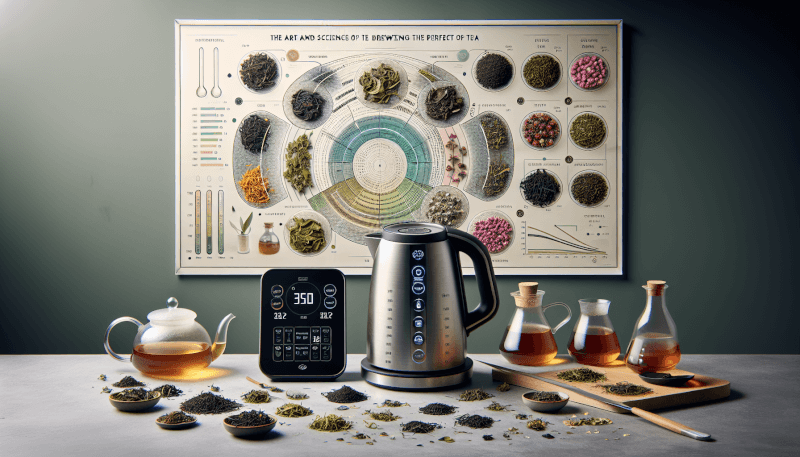Are you tired of making a cup of tea that always seems to be too weak or too bitter? Look no further, because we have the solution for you! In this article, we will explore the science behind tea brewing temperature control and how it can dramatically impact the flavor of your favorite beverage. By understanding the optimal temperature for each type of tea, you will be able to brew the perfect cup every time, unlocking a world of rich and nuanced flavors. So grab your tea leaves and get ready to elevate your tea brewing game to a whole new level of expertise!

The Importance of Tea Brewing Temperature Control
Tea brewing temperature control is a crucial aspect of achieving the perfect cup of tea. The temperature at which you brew your tea can significantly impact its flavor, aroma, and overall quality. Whether you are a casual tea drinker or a passionate tea connoisseur, understanding the importance of temperature control is essential for enhancing your tea-drinking experience.
How Temperature Affects Tea Flavor
The flavor profile of tea is influenced by several factors, with temperature being one of the most critical components. Different compounds and flavors within tea leaves are released at varying temperatures, making it essential to find the optimal brewing temperature for each specific tea type.
When tea is brewed at a higher temperature, the flavors tend to be more robust, intense, and bitter. This is because temperature influences the extraction of tannins, which are responsible for the astringency and bitterness in tea. On the other hand, brewing tea at a lower temperature can result in a milder and more delicate flavor profile, showcasing the tea’s subtle nuances and delicate aromas.
Understanding the Optimal Brewing Temperature
Each type of tea has an ideal brewing temperature, which allows for the maximum extraction of desirable flavors while minimizing the extraction of undesirable compounds. Different tea varieties, such as green tea, black tea, white tea, oolong tea, and herbal teas, require specific temperature ranges to unfold their unique characteristics fully.
For example, green tea is best brewed at a lower temperature, typically around 170°F (77°C). This lower temperature helps to preserve the tea’s delicate flavors, prevent bitterness, and showcase its vibrant green color. On the other hand, black tea requires a higher brewing temperature of around 212°F (100°C) to extract its full-bodied, bold flavors and rich aroma.
The Impact of Water Quality on Brewing Temperature
The quality of the water used for brewing tea can also affect the temperature and, consequently, the flavor of the tea. Water that contains impurities or has a high mineral content can significantly impact the brewing temperature, resulting in off-flavors or altered taste.
Opting for filtered or purified water is recommended to ensure a clean and consistent brewing temperature. This allows the true flavors of the tea to shine through without any interference from water impurities. Additionally, using water that is free from chlorine or metallic tastes can enhance the overall tea-drinking experience and allow for a more accurate assessment of the tea’s flavor profile.
Factors Influencing Tea Brewing Temperature
Several factors influence tea brewing temperature, including the type of tea, the tea leaves or bags used, and the overall water temperature.
Tea Type and Brewing Temperature
Different types of tea require specific brewing temperatures to achieve the best results. Green teas, as mentioned earlier, benefit from a lower brewing temperature. Black teas, on the other hand, thrive at higher temperatures. Oolong teas typically fall somewhere in between, requiring a medium temperature range for optimal enjoyment.
Herbal teas, which encompass a wide array of blends made from various herbs, spices, and botanicals, often have more flexibility in terms of brewing temperature. Certain herbs and flowers may benefit from lower temperatures, while others may require higher temperatures to extract their full flavors. It’s essential to consult the packaging or a reputable source for guidance on the optimal brewing temperature for herbal teas.
The Role of Tea Leaves or Bags
The type and quality of tea leaves or bags used can also have an impact on the brewing temperature. Loose leaf tea generally provides more control over the brewing process, allowing for adjustments in the temperature according to the tea type. This flexibility enables tea enthusiasts to experiment with various brewing temperatures to find their preferred balance.
Tea bags, while convenient, can sometimes limit the control over brewing temperature. However, some high-quality tea bags are designed to allow for proper water flow and extraction, ensuring a satisfactory cup of tea. It’s advisable to choose tea bags that are specifically designed for loose-leaf tea, as they often offer better control over the brewing temperature.
The Importance of Water Temperature
The quality and temperature of the water used for brewing tea play a vital role in the final taste. Water temperature affects the rate at which compounds are released from the tea leaves, determining the balance of flavors and overall satisfaction of the tea-drinking experience.
Using water that is too hot can lead to over-extraction of tannins, resulting in a bitter and unpleasant taste. Conversely, water that is too cold may not extract enough flavor from the tea leaves, leading to a weak and insipid brew. Finding the ideal water temperature for each tea type is crucial for achieving the optimal balance and getting the most out of your tea.

Methods for Controlling Tea Brewing Temperature
Controlling the temperature during tea brewing is a vital aspect of achieving consistent and flavorful results. Several methods can be employed to ensure accurate temperature control.
Traditional Methods: Kettles and Thermometers
The traditional method of using a kettle and a thermometer is reliable and effective for regulating tea brewing temperature. Electric or stovetop kettles equipped with temperature control settings allow you to heat the water to the desired temperature accurately. A separate thermometer can also be used to measure the water temperature before adding it to the tea.
By following the recommended brewing temperatures for specific tea types or experimenting with your preferred brewing temperature, you can achieve the desired flavors and aromas in your cup of tea.
Electric Kettles with Temperature Control
Electric kettles with temperature control functionality have made temperature regulation much easier and more convenient. These innovative appliances allow you to select the desired brewing temperature, and the kettle will automatically heat the water to the specified temperature. This eliminates the need for separate thermometers and simplifies the brewing process.
Electric kettles with temperature control are available in various price ranges and offer different features, such as preset temperature options, keep warm functions, and even programmable settings. Investing in a high-quality electric kettle can enhance your tea brewing experience and provide consistent results.
Smart Tea Brewing Devices
Advancements in technology have brought about smart tea brewing devices that offer precise control over brewing temperature. These devices often come with companion apps or preset brewing programs, allowing users to customize their tea brewing experience to their preferences.
Smart tea brewing devices typically use sensors and temperature probes to monitor the water temperature throughout the brewing process, ensuring accuracy and consistency. Some devices even provide real-time temperature updates and alerts, allowing you to monitor the brewing temperature with ease.
The Science Behind Tea Brewing Temperature
Understanding the science behind tea brewing temperature can deepen your appreciation for the art of tea making. Several chemical processes and reactions occur during the brewing process, which are influenced by temperature.
The Role of Polyphenols and Caffeine
Tea leaves contain polyphenols, which are organic compounds responsible for the distinct flavors and health benefits of tea. Polyphenols, along with caffeine, contribute to the overall flavor profile of tea and are influenced by brewing temperature.
At higher temperatures, polyphenols and caffeine are more easily extracted, resulting in a stronger and more robust brew. Lower temperatures, on the other hand, allow for a more gradual extraction, highlighting the tea’s delicate flavors and aromas.
The Extraction Process at Different Temperatures
The process of tea extraction involves the transfer of various compounds, including polyphenols, caffeine, and volatile oils, from the tea leaves to the water. This process occurs at different rates and intensities depending on the temperature at which the tea is brewed.
Hotter water speeds up the extraction process by increasing molecular movement, allowing for a quicker release of flavors. The hotter the water, the faster the extraction occurs. Cold water, on the other hand, slows down the extraction process, resulting in a longer brewing time to achieve the desired flavor concentration.
Chemical Reactions and Flavor Development
Temperature also plays a role in the chemical reactions that occur during tea brewing, leading to the development of complex flavor compounds. When tea leaves are exposed to hot water, volatile compounds are released, resulting in the distinct aroma and flavor of the tea.
Additionally, the interaction between polyphenols and tannins at higher temperatures can lead to the formation of more complex flavonoids and antioxidants. These compounds contribute to the overall taste and health benefits of the tea.
Understanding the science behind tea brewing temperature allows you to make informed decisions when it comes to selecting the right brewing method and temperature for your preferred tea type.

Experimenting with Tea Brewing Temperature
A fun and educational way to explore the impact of temperature on tea flavor is by conducting experiments with different brewing temperatures. By adjusting the temperature within a suitable range for each tea type, you can observe how it affects the taste, aroma, and overall experience of your favorite teas.
Exploring the Effects of High Temperature Brewing
For tea enthusiasts who enjoy strong and robust flavors, experimenting with higher brewing temperatures can be an exciting journey. By brewing tea at the upper end or even slightly above the recommended temperature range, you can extract more intense flavors, highlighting the tea’s bold characteristics.
However, it’s important to note that brewing at higher temperatures may also result in increased bitterness and astringency. It’s advisable to monitor the brewing time closely and adjust other factors, such as tea-to-water ratio, to maintain a balanced and enjoyable brew.
The Impact of Low Temperature Brewing on Tea
On the opposite end of the spectrum, brewing tea at lower temperatures can reveal the delicate nuances and subtleties of the tea. This is particularly beneficial for teas that are known for their delicate flavors, such as white tea or certain green tea varieties.
Brewing at lower temperatures allows for a more gradual extraction, preventing the tea from becoming too bitter or overpowering. It can also help to retain the tea’s original flavors and showcase its unique characteristics in a more pronounced manner.
Finding the Perfect Brewing Temperature for Different Tea Types
While it’s helpful to have general guidelines for brewing temperatures, experimenting with different temperature ranges can help you discover your perfect cup of tea. By taking note of the flavor profiles, aromas, and overall satisfaction of each variation, you can determine the ideal brewing temperature for your preferred tea types.
Keeping a tea journal or using a brewing temperature log can assist you in documenting your brewing experiments and tracking your preferences. This allows you to replicate your favorite tea experiences consistently and enhance your tea-drinking pleasure.
Tips and Best Practices for Temperature Control
To achieve the best possible results when it comes to tea brewing temperature control, there are several tips and best practices to keep in mind.
Preheating and Cooling Techniques
Preheating your teaware, such as teapots or cups, can help maintain a stable brewing temperature throughout the process. By pouring hot water into your teaware and allowing it to warm up before adding the tea, you can minimize heat loss and ensure a more accurate brewing temperature.
Conversely, if you find yourself in a situation where the water temperature is too high, you can employ cooling techniques to bring it down to the desired range. Adding a splash of room temperature or cold water to the kettle can help lower the temperature quickly.
Timing the Brewing Process
In addition to monitoring the water temperature, timing the brewing process is crucial for achieving consistent results. Using a timer ensures that you are brewing the tea for the appropriate duration, preventing over-extraction or under-extraction.
Different tea types have different recommended brewing times, which should be followed diligently to achieve the desired flavor profile. Timing the brewing process also allows you to keep track of the effects of temperature on the tea, allowing for adjustments and improvements in subsequent brewing sessions.
Monitoring Water Temperature
Investing in a reliable and accurate thermometer can be incredibly helpful in maintaining precise control over the water temperature. By regularly measuring the water temperature before brewing, you can ensure that you are within the recommended range for your chosen tea type.
There are various handheld thermometers and digital temperature probes available on the market, catering to different budgets and preferences. Choose a thermometer that provides quick and accurate readings, making it easier for you to fine-tune your brewing temperature.

Conclusion
Tea brewing temperature control is a fundamental aspect of tea preparation that should not be overlooked. By understanding how temperature influences flavors, aroma, and chemical reactions, you can unlock the full potential of your teas and enjoy a more gratifying tea-drinking experience.
Experimenting with different brewing temperatures, exploring the effects of high and low temperature brewing, and finding the optimal temperature for each tea type allows you to customize your tea to your preferences. By employing various temperature control methods, such as traditional kettles, electric kettles with temperature control, or smart tea brewing devices, you can enhance your tea brewing skills and ensure consistent results.
Remember the importance of water quality on brewing temperature and the role of tea leaves or bags. By monitoring water temperature, preheating or cooling techniques, and timing the brewing process accurately, you can fine-tune your tea preparation and ensure that every cup of tea is a delightful experience. So, grab your favorite tea and embark on a journey of temperature exploration to unlock the true flavors and delights of your teas. Cheers to the perfect cup of tea!

